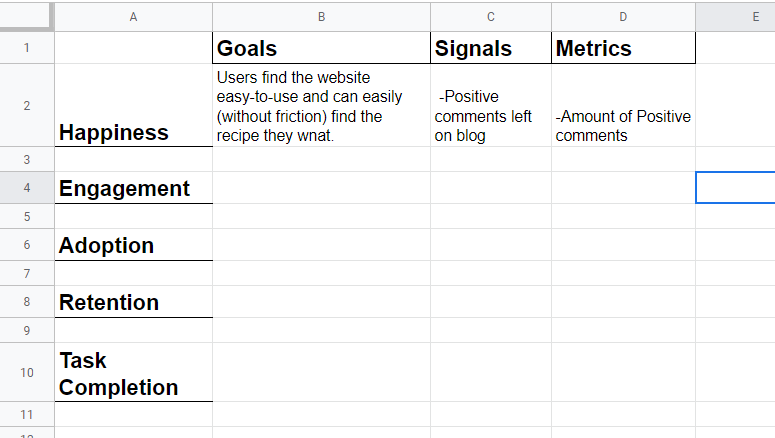
You spend tons of time on SEO and social media to get people to your site, but how much time do you spend making sure they stay, love it, and convert into long-term followers?
Making your blog user-friendly is an area that often gets overlooked, but it’s actually just as, if not more important than SEO.
SEO is a subset of the user experience. What Google and other search engines want, is to provide the best search result to their searchers, and that all comes down to the searcher’s experience on the search result page.
HOW TO MEASURE USER-FRIENDLINESS
So then, the question becomes, how to create and measure content your readers will love. How do you know if you are connecting with readers instead of just search engines?
⠀
One of the best tools out there to help you wrap your head around this is called the HEART framework. A team at Google developed this as a way to help people measure the user experience in web applications. (Read the full in-depth article from Google in this pdf.)
⠀
HEART’s key metrics:⠀
- HAPPINESS: This measures overall satisfaction. Do your readers feel your blog is working well for them?⠀
- ENGAGEMENT: How do your readers interact with your blog? For example, do they click through to different recipes, sign-up for your opt-ins or leave comments?⠀
- ADOPTION: How many new readers are you receiving? This is where SEO and social media platforms make a difference.⠀
- RETENTION: How many of your new readers become regular readers?
- TASK SUCCESS: How easily can people visiting your blog accomplish what they came to do? On a food blog, the basic task people are usually trying to accomplish is to view and make your recipe. Can they do it easily?
I’ll break down each below.
Happiness
At first, this may seem like a measurement that is a bit ridiculous and can’t be quantified. But, from the user experience mindset, happiness is really key.
Happiness entails the whole experience, from start to finish, and often even before and after. Happiness with your blog and brand is something that never ends.
This metric is best measured by actually asking users how they feel about your site.
For instance, the Net Promotor Score of your site, which is where users are asked the likelihood that they would recommend your site, can serve as a great insight.
Using a tool like HotJar allows you to put surveys and record heatmaps on your site and get real feedback from actual users. This allows you to see what users actually think and do without guessing.
Engagement
How well and to what degree users engage with elements on your blog should always be key factors.
For a food blog, you might not see as much engagement as some types, as many people come “just for the recipe.”
But even recipe engagement is something that should be measured. That can be done by looking at metrics, among many, such as time on page and how many reviews or comments you receive on a recipe page.
Beyond that, if your site (and recipe) is good, readers will want to click through to learn more about you, view other recipes, purchase items, or sign up for your newsletter.
Ultimately, that should be your goal anyway–to create readers who want to engage with you in other ways beyond just one recipe.
Adoption
This is the category where most food bloggers focus. SEO falls here, as well as anything you do to get eyeballs on your site.
Adoption is typically measured through page views and/or sessions per month through a tool like Google Analytics.
You can also analyze the adoption of other specific tasks, such as the success of people signing up for your newsletter, or how many people purchase a product you sell.
Retention
Are your readers coming back?
This is a huge factor, as it’s easier to keep a reader that’s already familiar with you than to get a new one.
If all these other elements are put into place, you should be retaining readers.
You can measure this through reports in Google Analytics, such as “New vs. Returning Users” and the “Cohort Report.”
Email and social media are both great at helping you retain readers, as once they subscribe or follow you, they should (hopefully!) always be there and stay connected.
Task Success
This category often gets drastically overlooked, especially for food bloggers.
If the majority of people visiting your site come to make a recipe, how easy is it for them to access that recipe?
Honestly, this one creates quite a bit of friction between you as a food blogger and your readers, as the readers often want to see the recipe first, while food bloggers want it last to optimize ad views and SEO.
From a true user experience perspective, having the recipe card first, or near the top would be best. The “Jump to Recipe” button is a decent compromise but is still basically a band-aid around this issue.
So, you should do everything you can to make sure your recipe card is easy-to-find and easy-to-read. Make it stand out from everything else, add the “Jump to Recipe” button, limit ads in the recipe card and so on.
The easier your readers find it to access your recipe, the happier they will be.
Goals-Signals-Metrics
Google also outlines a way to set goals and measure them around the HEART framework, called Goals-Signals-Metrics.
When you place this all into a grid, as shown below, you can see how it becomes a great way to measure the user experience on your blog.

In this case, the goal is what you want to happen, the signal will be things that can be measured, and then the metric is the actual measured results.
When you fill this all out and get results, you come away with a very well-rounded picture of how user-friendly your site is, and where you can improve.




